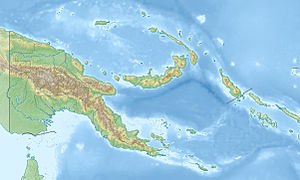Bramble Haven
| Bramble Haven | ||
|---|---|---|
| NASA satellite image of the atoll | ||
| Waters | Solomon Lake | |
| archipelago | Louisiade Archipelago | |
| Geographical location | 11 ° 14 ′ S , 152 ° 0 ′ E | |
|
|
||
| Number of islands | 5 | |
| Main island | Punawan | |
| length | 19.5 km | |
| width | 10.8 km | |
| Land area | 70 ha | |
| Lagoon area | 110 km² | |
| total area | 175 km² | |
| Residents | uninhabited (2000) | |
Bramble Haven is an uninhabited atoll in the Louisiade archipelago . Politically, the islands of the atoll belong to the Milne Bay province in the southeastern part of Papua New Guinea .
Bramble Haven is the easternmost part of a large chain of atolls, reefs and islands, the western side of the barrier reef of Vanatinai than 400 km to the west, to the south coast of Papua peninsula extend.
The atoll was named after the schooner Bramble , with whom Charles B. Yule took part in an expedition by Owen Stanley and entered the port basin formed by the reefs on August 5, 1846.
Bramble Haven is 5 km east of Long Reef and 9 km west, separated by the Jomard Passage (English: Jomard Channel), the outer reefs of the barrier reef on Vanatinai Island. The Jomard Islands are located between Bramble Haven and Vanatinai . Bramble Haven is a small, 17 km wide, 11 km long atoll-like formation. The five main reefs are arranged around a rectangular central lagoon . The reefs are usually wide and largely under water or are temporarily flooded.
The reefs in the northern part of Bramble Haven form five islets, also known as Duperré Islands: Punawan (51 ha ), the small Duperre Island, Siva, Panapwa and Awanagamwana.
Misima Paneati is spoken on the islands . The language belongs to the East Malaysian-Polynesian language group.
Bramble Haven has been in the “Mixed Objects” category since 2006, which combines criteria of both cultural and natural heritage, together with the Conflict Islands , the Jomard Islands as well as Samarai and Lunn Island under the name: Milne Bay Seascape (Pacific Jewels of Marine Biodiversity) on the Tentative list of Papua New Guinea for the list of world heritage of UNESCO .
Web links
- Bramble Haven on Oceandots.com (further information & pictures) ( Memento from December 23, 2010 in the Internet Archive ) (English)
Individual evidence
- ↑ Arthur Wichman (ed.): History of the discovery of New Guinea (until 1828). Vol. 1, EJ Brill, Leiden 1909, p. 72
- ^ M. Paul Lewis (ed.): Misima Paneati, A language of Papua New Guinea Ethnologue: Languages of the World. SIL International, Dallas 2009
- ↑ Milne Bay Seascape (Pacific Jewels of Marine Biodiversity) UNESCO , World Heritage Center

